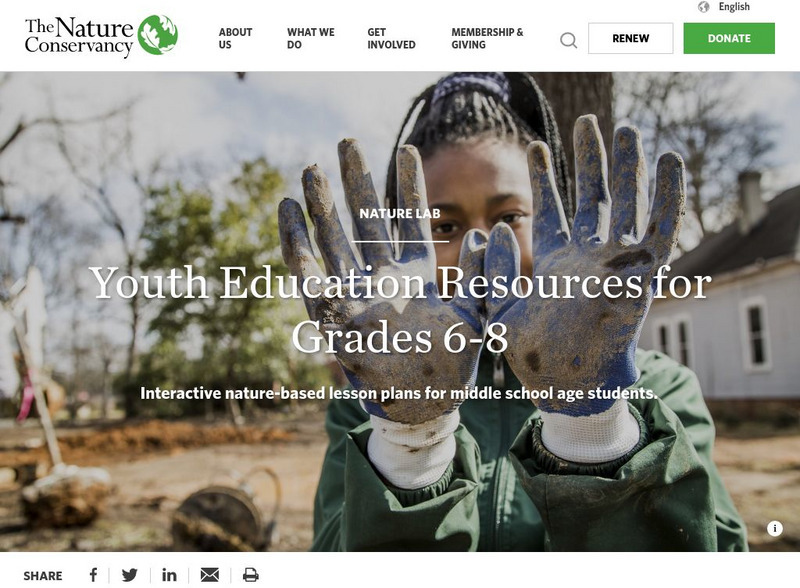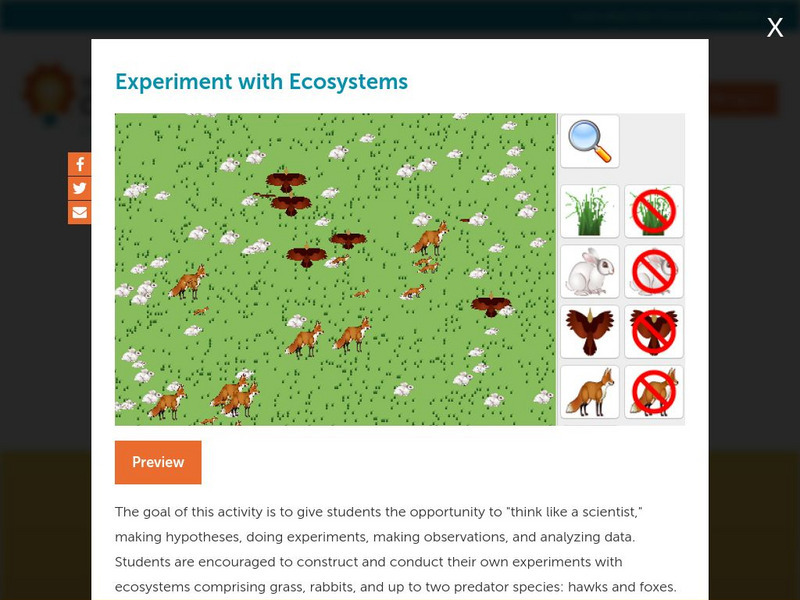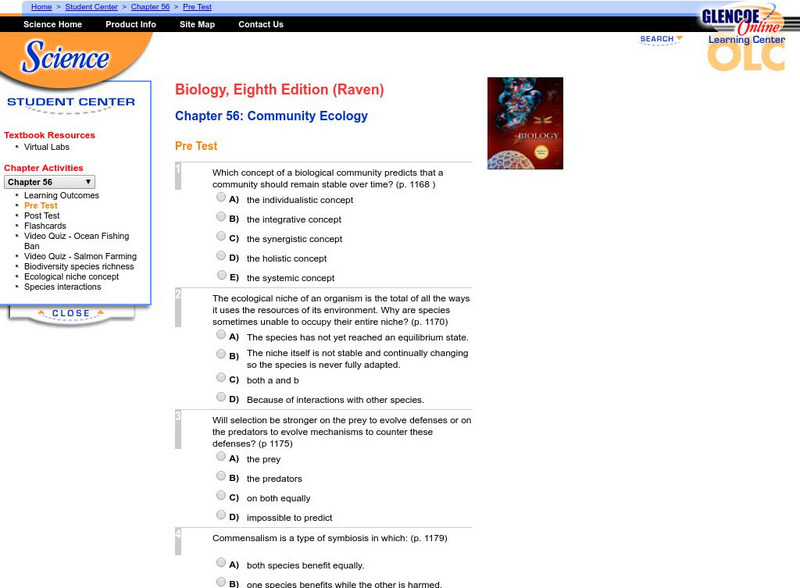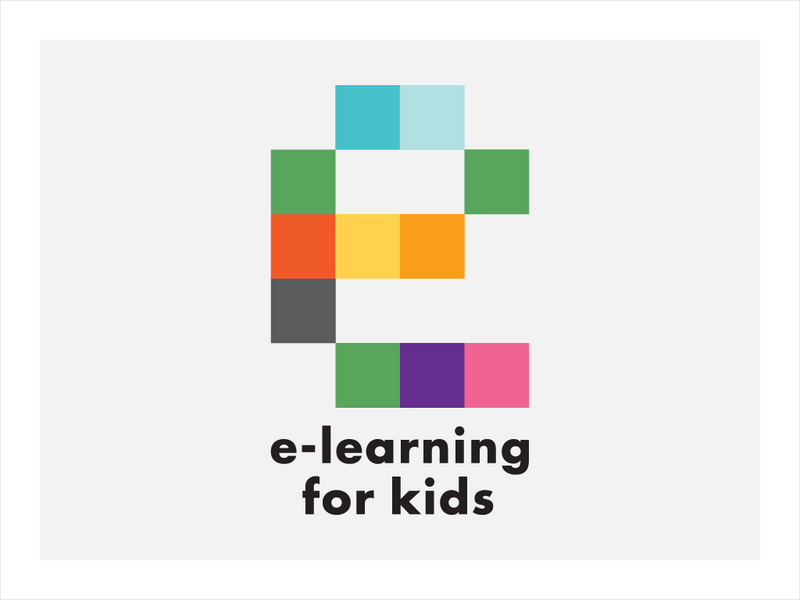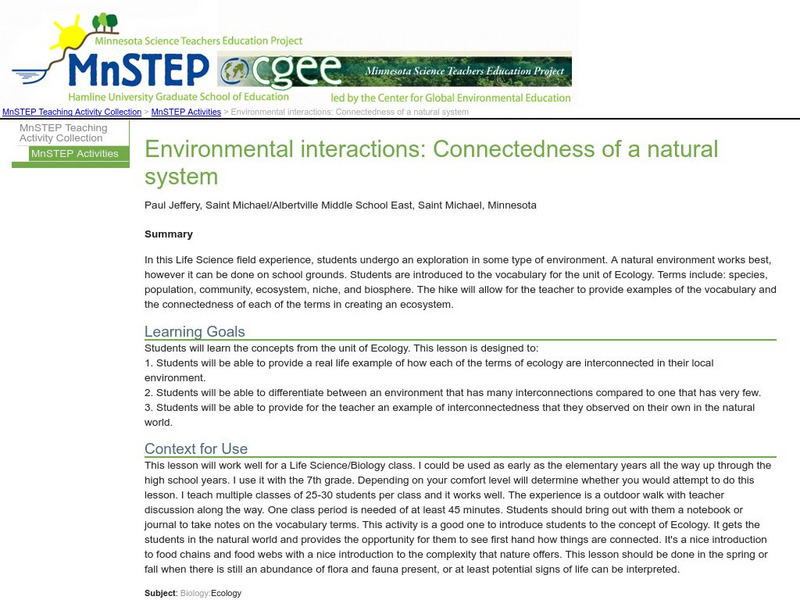Science Education Resource Center at Carleton College
Serc: Investigation a Food Web: Producers, Consumers, and Decomposers
Being field scientists, students will explore a wooded area in their community and journal about their observations. Students will collect information about producers, consumers, and decomposers in the ecosystem. They will then construct...
American Association for the Advancement of Science
Aaas: Project 2061: Topic: Interdependence in Ecosystems
[Free Registration/Login Required] Create a science test that checks for student understanding in science, for common misconceptions, as well as for correct ideas. This is a list of key ideas related to Interdependence in Ecosystems. For...
National Geographic
National Geographic: Ecological Relationships
In this lesson, students learn about different types of ecological relationships, including symbiosis, mutualism, commensalism, and parasitism. Includes handouts and a vocabulary list with definitions.
Annenberg Foundation
Annenberg Learner: The Habitable Planet: Ecosystems: Energy Flow Through
Detailed explanation of the processes by which energy flows through an ecosystem. Scroll down and open Section 3.
Nature Conservancy
The Nature Conservancy: The Importance of Biological Interactions
Organisms have a variety of relationships. For this lesson, students learn to categorize relationships according to their impact on organisms and the terminology for these biological interactions.
TeachEngineering
Teach Engineering: Environmental Interactions
In this activity, students create a "web" to identify and demonstrate the interactions among the living and non-living parts of an environment. This information allows students to better understand what an environment is and to also...
Other
The Habitable Planet Simulation
This activity is designed to accompany an interactive on the Annenberg Learner website. Students investigate the changes that take place in an ecosystem when they alter the organisms in a food web. As they work with the simulation, they...
Annenberg Foundation
Annenberg Learner: The Habitable Planet: Ecology Lab
Create the parameters of your own ecosystem by choosing which producers and consumers live there. Visualize how the food web operates and species populations change. This simulator mimics the food web within a typical ecosystem and gives...
Other
Texas/fossil Rim Wildlife Center
Fossil Rim is a refuge center for endangered species and is located "50 miles southwest of Fort Worth." The site is an excellent resource for classroom teachers and students. It features word games, coloring pages, pictures and...
Concord Consortium
Concord Consortium: Stem Resources: Experiment With Ecosystems
Learn what happens to different populations of organisms as their ecosystem changes. Design your own experiment and make your own guesses with what the result will be with this virtual ecosystem. Also experiment with producer/consumer...
Better Lesson
Better Lesson: Butterfly Bush Visitors
In this instructional activity, the children learn about how critters depend on the butterfly bush and how the butterfly bush, in turn, depends on it. Common Core writing skills are integrated as they take it to the next step, and create...
McGraw Hill
Glencoe: Biology: Community Ecology
Find out what you know about community ecology by taking this interactive pretest.
E-learning for Kids
E Learning for Kids: Science: Bermuda Triangle: How Is Energy Transferred Between Organisms?
Bermuda is a mysterious place. Meet Scotty and his family and join them on their holiday to learn about energy transfer in ecosystems.
E-learning for Kids
E Learning for Kids: Science: South Africa: How Do Organisms Get Their Energy?
Join Ellen on her trip to the Kaap De Goede Hoop in South Africa, and learn more about plants, animals, and energy.
Environmental Education for Kids
Eek!: Alien Invaders
The aliens have landed in Wisconsin! You may see them and not even know they are aliens. These invaders are actually exotic plants and animals that have been introduced to our state from other countries or habitats on purpose or by...
Science Education Resource Center at Carleton College
Serc: Ecosystem Study
Studets investigate the health of an ecosystem and the effects of water, sunlight, nutrients or pollutants. They determine the change in the environment through observation, journaling, and measuring growth of the plants and living...
Science Education Resource Center at Carleton College
Serc: An Introduction to and Investigation on Keystone Species
A middle school ecology project in which students learn about ecosystems and the keystone species which inhabit them.
Science Education Resource Center at Carleton College
Serc: Environmental Interactions: Connectedness of a Natural System
A field experience where students undergo an exploration in a natural environment. They are introduced to the concepts of species, population, community, ecosystem, niche, and biosphere.
Science Education Resource Center at Carleton College
Serc: The Microenvironment Project: Featuring Phenology
A field lab for biology that focuses students on the study of nature and its changes over time. Students are asked to observe and acquire knowledge of trees and the interdependence that a tree shares with other organisms.
Science Education Resource Center at Carleton College
Serc: Mn Step: Schoolyard Bio Blitz
For this activity, students visit a small section of the schoolyard and record observations in a scientific journal. They will observe different things as the school year progresses, including ecological relationships, human impact on...
Science Education Resource Center at Carleton College
Serc: Bio Media Associates: Learning Programs for Biology
This site provides photographs, animations, essays, teaching resources, multimedia, and other information about biological systems and organisms. It features a monthly contest and quiz in which students and teachers identify a mystery...
Ohio State University
Ohio State University: Concepts of Plant Ecology
An advanced discussion of plant interactions and relationships. Energy flow, nutrient cycling and succession are discussed. Try the quiz to check your understanding.
Oswego City School District
Regents Prep: Ecosystems/communities
Abiotic factors vary in the environment and determining the types and numbers of organisms that exist in that environment. Factors which determine the types and numbers of organisms of a species in an ecosystem are called limiting...
TED Talks
Ted: Ted Ed: Feedback Loops: How Nature Gets Its Rhythms
Anje-Margriet Neutel describes some common positive and negative feedback loops, examining how an ecosystem's many loops come together to make its 'trademark sound.' [5:11]






